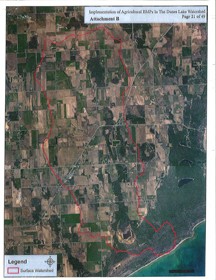Dunes Lake Watershed Faces Overgrowth
- Share
- Tweet
- Pin
- Share

The Dunes Lake Watershed, the surface of which is outlined here, is in danger of overgrowth due to an excessive presence of phosphorus and nitrogen in the water.
The Dunes Lake Watershed is in danger of being overrun with algae and duckweed, according to the preliminary findings of a study conducted by the Door County Soil and Water Conservation Department (SWCD).
Bill Schuster, the head of the SWCD, laid out the basic premise of his department’s study at the County Board’s May 22 meeting.
“The lake is essentially dying quickly – faster than a lake should be dying,” said Schuster. “There’s an excess of nutrients to the point where the lake can’t assimilate those without rapid change.”
Most of the excess consists of extra phosphorus and nitrogen that is running off land on the watershed and entering the lake via Geisel Creek. That phosphorus and nitrogen is fostering the growth of water lentils and algae which will eventually overwhelm the lake in Sevastopol and clog the flow of the watershed system. Schuster said that this process does eventually occur naturally, but not at the rate that is currently being seen at Dunes Lake.
Schuster hopes to present the SWCD study at public meetings throughout the fall, after it has been vetted by scientific peer review. In the meantime, the County Board voted to accept and approve the use of a Targeted Runoff Management grant from the DNR, totaling $529,400, to combat the problem.
Most of the money will be used to help landowners near the watershed institute what are known as best management practices (BMPs). These include the installation of vegetation that will filter the excess nutrients out of the water before it reaches the watershed and the regulation of nutrient use, i.e. fertilizers, by farmers.
In order to mandate that landowners institute the BMPs, the county would have to provide 70-90 percent of the funding for them. Otherwise, any efforts made will be strictly voluntary.
Schuster is hoping that everyone located on or near the watershed will be willing to help slow the flow of nutrients.
“All land uses within the watershed contribute nutrients, and all the landowners are going to have to pitch in,” he said. “There are some fairly low cost, low pain things that people can do to reduce nutrients coming into the system.”
Schuster said that his department plans to start touching base with landowners on the watershed sometime within the next 30 days.
